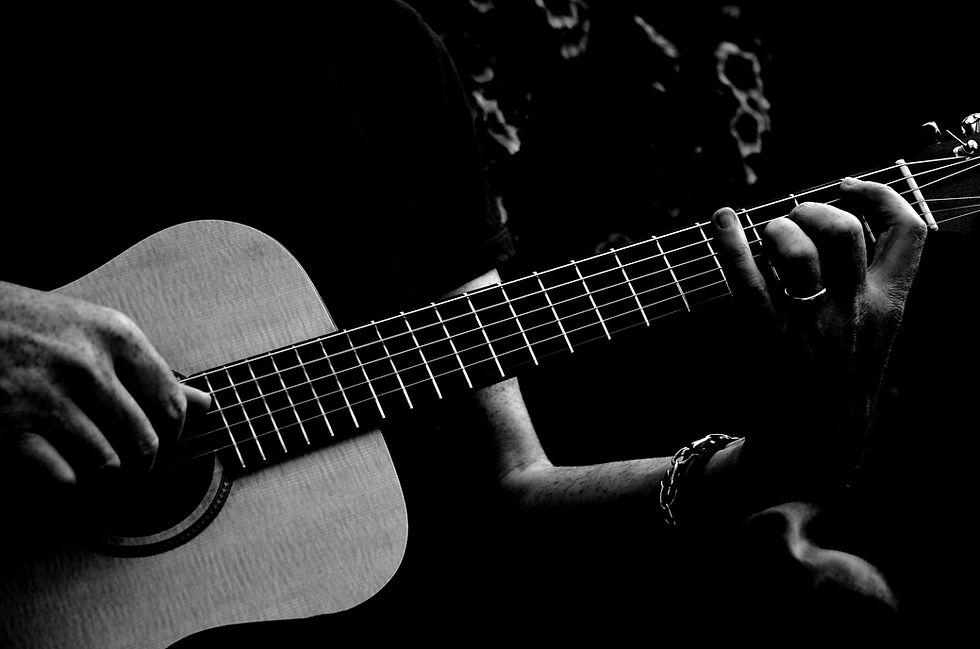Tuning your guitar - the right way!
- Oli Kipfer

- May 13, 2024
- 7 min read
Updated: Jul 11, 2025
Have you bought a new guitar or electric guitar and want to learn how to tune it properly? Then we have just the thing for you. Find out more in this blog article about the different ways you can tune your guitar and what tools are available for this.

What types of guitars are there?
There are different types of guitars, each suitable for different musical styles and preferences. Acoustic guitars produce their sound through the vibration of the strings, which resonate in the hollow body of the instrument, making them ideal for folk, country and singer-songwriters. Electric guitars, on the other hand, use pickups to convert the string vibrations into electrical signals and are often associated with rock, jazz and blues music due to their versatility and ability to produce amplified sounds. Other guitar types include classical guitars with nylon strings and a wider neck, which are often used in classical music and flamenco, as well as bass guitars with longer scale lengths and thicker strings, which form the foundation for the low notes in many bands of different genres. Finally, there are semi-hollowbody guitars, which combine features of acoustic and electric guitars and are appreciated for their warm, resonant sound, which is popular in jazz and blues contexts.
What tunings are there for guitars?
Guitar tunings are very different and can have a significant effect on the sound and playing style. Here are the most common guitar tunings:
Standard tuning: Standard tuning (EADGBE) is the most widely used guitar tuning. It offers a balanced sound on all strings and allows the player to play a wide range of chords and melodies with ease. Its versatility makes it suitable for a variety of genres, from rock and pop to folk and jazz, and it serves as the basis for many guitar techniques and teaching materials.
Drop D tuning: In Drop D tuning (DADGBE), the low E string is lowered a full step to D, allowing for heavier and more resonant power chords with a lower pitch. Popular in rock, metal and acoustic music, drop D tuning adds depth and richness to guitar arrangements, facilitates simple power chord shapes and allows players to explore new sonic territories.
Open G tuning: The open G tuning, DGDGBD, produces a G major chord when strummed open and offers a rich and full sound that is ideal for slide guitar and blues music. It allows for simple chord shapes with a booming G note and is well suited for fingerstyle playing and open chord progressions common in folk and country music.
Open D tuning: The open D tuning, DADF#AD, produces a D major chord when strummed open and produces a warm and resonant sound that is well suited for fingerstyle playing and slide guitar. The open D tuning is used in a variety of genres, including blues, folk and rock, and offers unique chord variations.

How can I tune my guitar?
With a tuner: A tuner gives precise visual feedback on whether a string is in tune or not and is therefore ideal for beginners. It can be a standalone device or a smartphone app and offers convenience and accuracy.
With an app: To tune a guitar with an app, simply open the app on your smartphone or tablet and select the tuning mode for the instrument (e.g. standard guitar tuning). Pluck each string individually. The app analyzes the sound and provides visual feedback to guide you in adjusting the tuning pegs until each string has reached the desired pitch.
Tuning by ear: This method is based on developing a good ear for pitch and can be useful in situations where a tuner is not available. It involves comparing the pitch of each string with a reference tone, e.g. another instrument or a tuning fork.
Using a tuning fork: Tuning forks produce a fixed pitch and serve as a reliable reference point for tuning each string. By striking the tuning fork against a surface and then placing it against the body of the guitar, you can adjust the pitch to that of the tuning fork.
With a guitar amplifier: To tune a guitar with an amplifier, simply connect the guitar to the amplifier with a standard 1/4-inch instrument cable. Play each string individually and adjust the tuning pegs until the tone coming from the amplifier matches the desired pitch.
How does tuning with a tuner work?
A guitar tuner works by picking up the sound waves produced when a guitar string is struck. This is usually done using a built-in microphone or a vibration sensor. The tuner then processes these sound waves and identifies the frequency of the vibration of each string. It compares this frequency with the standard frequencies associated with the desired tuning for each string. Finally, the tuner displays the determined frequency and guides the player to adjust the tuning pegs until the string reaches the desired pitch to ensure accurate tuning.
Where can I buy a tuner?
You can buy tuners in any specialist store that also sells guitars, electric guitars or ukuleles. Tuners can also be purchased online. They are usually relatively easy to use and do not require a great deal of knowledge, making them suitable for beginners. You can buy tuners for guitars at Musik Hug, for example.
How much does a good tuner cost?
Analog and digital tuners for guitars have been around for a relatively long time. The technology behind them is also not very complex and you can buy a good tuner from around CHF 10. The more expensive models with visual effects or displays can be a little more expensive and range from around CHF 30 - CHF 50.

How does tuning a guitar with an app work?
When tuning a guitar with an app, the device's microphone is usually used to capture the sound produced by each string as it is plucked. The app analyzes the frequency of these sound waves and compares them to the standard frequencies associated with the desired pitch of each string. It then gives the user visual feedback as to whether the string is in tune or needs to be retuned. The player can then adjust the tuning pegs accordingly until the app signals that the string is in tune. Overall, guitar tuning apps offer musicians a convenient and accurate way to ensure their instruments are tuned for optimal sound quality.
What apps are available to tune my guitar?
GuitarTuna: GuitarTuna is a popular tuner app known for its accuracy and user-friendly interface, making it suitable for beginners and experienced players alike. It provides tunings for various stringed instruments including ukuleles and bass guitars, and offers additional features such as chord diagrams and a metronome.
Fender Tune: Developed by renowned guitar manufacturer Fender, Fender Tune provides precise tuning for acoustic and electric guitars to ensure optimal sound quality. The app offers automatic tuning modes for quick and easy tuning as well as advanced manual tuning options for those who want more control over the sound of their instrument.
Pro Guitar Tuner: Pro Guitar Tuner is known for its accuracy, making it a favorite among professional musicians and guitar technicians. It supports the tuning of a wide range of instruments, including guitars, basses, violins and more, and offers customizable tuning settings to accommodate different playing styles and preferences.
PitchLab Guitar Tuner (Android): PitchLab Guitar Tuner is a versatile tuner app for Android devices that offers precise tuning functions as well as additional features such as a chord library and scale diagrams. The responsive and intuitive user interface makes it easy to use, while the pitch detection technology ensures accurate tuning even in noisy environments.
Cleartune: Cleartune is known for its simplicity and reliability and offers clear and easy-to-read tunings.
Simply Guitar: Some guitar learning apps also come with a tuner. They are not free, but if you have a subscription anyways, this is a way to tune your guitar.

How can you tune a children's guitar?
Guitars for children come in different sizes and styles, with smaller necks and bodies to suit smaller hands and body sizes. The most common types include 1/4, 1/2 and 3/4 guitars. These guitars can be tuned in a similar way to normal guitars using tuning pegs, but due to their smaller size they may need to be adjusted to achieve the correct tension and intonation. To tune a children's guitar, a tuner or tuning app is used to adjust the strings to the desired pitch, usually according to standard tuning (EADGBE). Despite their smaller size, the tuning process remains the same, as the relative tension and spacing between the strings remain the same regardless of the size of the guitar.
Can bass guitars also be tuned?
Tuning a bass guitar differs from tuning a normal guitar mainly in terms of the range and string arrangement. Bass guitars usually have four strings tuned to EADG, whereby the strings are thicker and tuned to lower frequencies than on a normal guitar. When tuning a bass guitar, it is important to ensure that each string is tuned to the desired pitch, which is usually done with a tuner or tuning app. Also, due to the thicker strings and lower frequencies, bass guitars may need to be tuned more precisely to get the right tension and intonation. Despite these differences, the basic process of tuning a bass guitar is similar to tuning a normal guitar and focuses on setting each string to the correct pitch for optimum sound quality and playability.
How do you tune a ukulele correctly?
Tuning a ukulele differs from tuning a guitar mainly in the number of strings and the pitch intervals. Ukuleles usually have four strings, each tuned to a specific note, whereas guitars have six strings. The most common tuning for a ukulele is GCEA, where the strings are tuned to G, C, E and A from top to bottom. To tune a ukulele, each string must be set to these pitches using a tuner or tuning app. Unlike guitars, ukuleles often require re-centered tuning, where the strings are not tuned in order from the lowest to the highest note, which gives the instrument's sound a unique character.
Conclusion
Overall, there are a variety of guitar types, each suitable for different styles of music and players. From acoustic and electric guitars to bass guitars and classical guitars, they offer a wide range of options for musicians of all levels. Tuning these guitars can be done using tuners, apps or even by ear, with the basic principles being similar for each type of guitar. Despite the differences in size and sound, the basics of tuning remain constant, and with the right tools and techniques, musicians can ensure their instruments sound and play at their best.










Comments